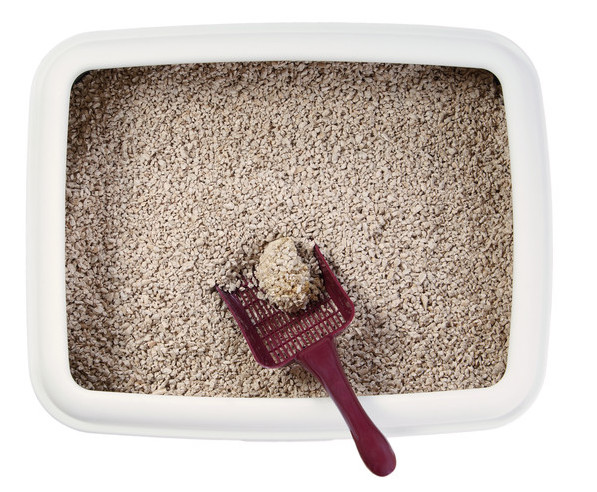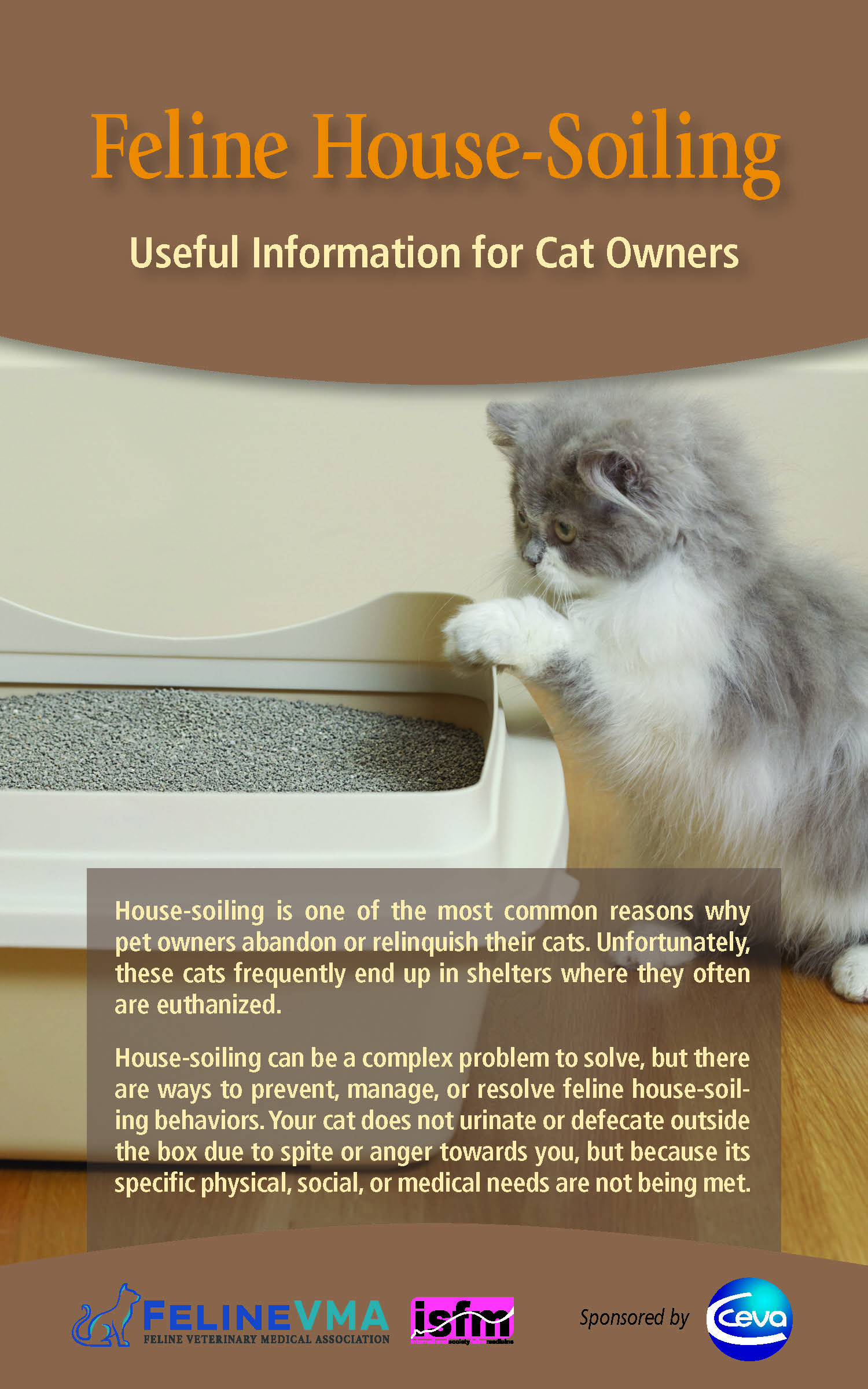Feline house-soiling can be a frustrating problem, but this issue can be solved with patience and education to find out why your cat is not using their litter box. This may involve making changes to several aspects of your cat’s home environment and care.
Please remember when your cat doesn’t use the litter box, this is a sign his or her physical, social, and/or medical needs are not being met. Your cat does not urinate or defecate outside the box due to spite or anger towards you, even though it may feel that way.
Four Basic Causes of House-Soiling
Environmental and Social Factors
Cats by nature are very clean animals and need enough unsoiled litter boxes to eliminate, especially in a multi-cat household. Some cats may avoid using a litter box if it’s located in an undesirable location, like a high traffic area or near cat doors/flaps. In a multi-cat household, the presence of a more dominant cat near the litter box area may cause a less confident cat to seek out other places for elimination. House-soiling may occur if a cat had a negative experience while he was in or near the litter box (e.g., someone administered medications, family members or children trapped a cat in the box for any reason, if the litter box is dirty, or even being startled by sudden noises from nearby furnaces or other loud appliances).
Marking Behavior
Urine spraying is a normal part of feline behavior—it’s one way a cat marks to leave its scent. Marking behaviors can include scratching, rubbing, urine spraying, and middening (depositing feces). Unneutered male cats and most unspayed females will mark as part of their sexual behavior. Spaying and neutering dramatically reduces this behavior.
Anxiety-related marking occurs in response to a change in the cat’s environment, especially the core area where your cat eats, sleeps, and plays. Cats often target items with new or unrecognized smells such as backpacks and shoes. Marking behavior that starts at windows and doors usually suggests the perceived threat is coming from outside the home. If your cat is marking in stairways, hallways, doorways, or the center of rooms, this usually indicates stress or threats from inside the home, such as other pets or new people in the household, active children, or remodeling.
Medical Causes and Problems
Medical issues can also cause a cat to house-soil. Your veterinarian will be able to diagnose or rule out any medical conditions that could be a factor in house-soiling behavior. If your cat starts to house-soil, he or she requires a thorough physical examination by a veterinarian and urinalysis to check for medical problems such as infections, cystitis, arthritis, kidney problems, diabetes, and other medical issues.
If your veterinarian believes the house-soiling behavior is caused by a medical reason, they may perform additional tests such as a urine culture, abdominal radiographs, abdominal ultrasound, complete blood count, and biochemical profile. Digital rectal exams or fecal testing may be needed for cases of house-soiling with feces.
Feline Idiopathic Cystitis
Feline idiopathic cystitis (FIC) is a frequent medical cause of house-soiling. Cats suffering from FIC have increased frequency of urination, difficulty, and pain when urinating, and can have blood in their urine. This inflammatory condition can increase and decrease in severity over time and is aggravated by stress, changes in diet, and other issues.
Treatment and Management of House-soiling
The design and management of the litter box are critical for encouraging acceptable toileting habits. When house-soiling occurs, you should always start by evaluating the litter box.
Designing an Optimal Litter Box
Number
The general rule of thumb is to have one litter box for each cat, plus one extra box in multiple locations around your home. Socially affiliated cats (two or more cats that are familiar to each other), share a territory, and exhibit behaviors such as grooming, playing, or resting together, may be more willing to share litter boxes. Because more than one social group may occur in a home, providing adequate resources for each group is important to decrease the chance of adverse behaviors.
Location
We recommend to avoid placing food and water close to the litter box. Additionally, cats usually prefer quiet, private places so avoid busy areas of the home and locations where a cat could be cornered in, blocked off, or unable to flee.
Cats can be cornered in the litter box so they are unable to flee (e.g., if the box is in a closet or small room where another cat can block the exit). If one cat prevents another cat’s access to the litter box (e.g., the box is down a hallway or in a room where another cat can block entry), it can be very stressful and cause that cat to house-soil because they are avoiding or cannot get to the litter box location.
Keep the litter boxes apart in different locations because your cat considers boxes close to each other one large litter box. If your cat is toileting away from the box, try placing an additional litter box at the new site (temporarily or permanently) to get your cat using a box again. In a multi-level home, place a litter box on each level. If you have an older cat, place a litter box on the level where your cat spends the most time, as it may not be easy for the cat to go up and down stairs each time it needs to use the box.
Size
In general, bigger is better and many commercial litter boxes are too small. Litter boxes should be 1.5 times the length of your cat from the nose to the base of the tail. Suitable alternatives can include concrete mixing trays or storage containers. You can place the lid behind the box to protect the wall. Older cats need a low entry so you can cut down the side, but make sure you inspect for any sharp edges.
Litter
If your cat is exhibiting house-soiling behaviors, you may need to try different types of litter until the cat indicates its preference. For preference evaluation, provide multiple boxes with different litters and variable litter depths. Many cats dislike aromatic or dusty litters, litter deodorizers, and box liners. Most cats prefer soft unscented clumping litters.
Managing the Litter Box
Please remove any waste in the litter box at a minimum of once per day and add litter as needed. Make sure to wash the litter box every 1-4 weeks using soap and hot water only. Since cats have an incredible sense of smell, avoid strong chemicals or any ammonia-based products.

Remove Marking Triggers
Speak with your veterinarian to see if you should neuter or spay your cat to physiologically eliminate sexually-related marking behavior. Try to restrict the potential threat of other cats such as outdoor roaming cats who may be encroaching on your household and triggering marking behavior in your cat. You may want to remove or block cat doors that allow roaming cats to enter your household.
Cat Friendly Tip
If your cat resides indoors only (never goes outside), use motion-activated water sprinklers to make your yard unattractive to feline visitors. Laying plastic carpet protectors upside down in front of sliding glass doors creates an uncomfortable surface and may dissuade other cats from sitting close to your house and intimidating your cat.
Cat Friendly Tip Use microchip- or magnet-operated devices to only allow access to your cat.
You should clean urine-marked areas frequently to reduce your cat’s habit of refreshing its scent on the marking site and can use a black light (UV) to find soiled areas. Make sure to use a good quality urine odor and stain remover to clean affected areas according to the type of surface that your cat has soiled. We recommend you test products on an inconspicuous area first and clean a sufficiently large area to remove the odor, which may be up to three times the size of the soiled area. Again, please avoid using ammonia-based cleaners, which smell like urine to a cat.
Ensure that all your cat’s environmental needs are being met and never punish your cat for house-soiling. Punishment can lead to fear-related aggression, reduces the bond between you and your cat, and encourages urine marking in less obvious areas. Consider using comforting synthetic pheromones in your home. You can spray Feliway® on affected areas after cleaning to reduce the likelihood of re-marking. After individualizing toileting areas for your cat’s preferences, add a Feliway® diffuser in the room most frequented by your cat to reinforce the feeling of security.



